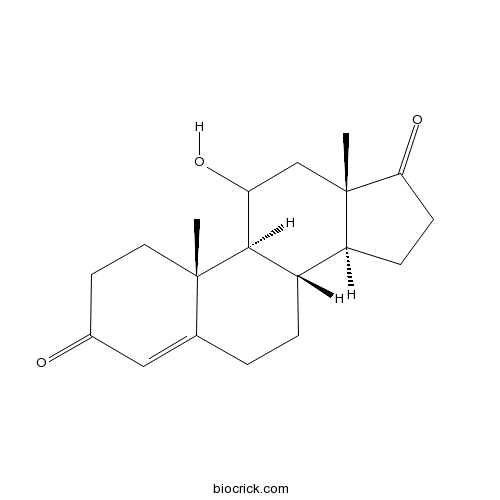11α-Hydroxyandrost-4-ene-3,17-dioneCAS# 564-33-0 |

Quality Control & MSDS
3D structure
Package In Stock
Number of papers citing our products

| Cas No. | 564-33-0 | SDF | Download SDF |
| PubChem ID | 108106 | Appearance | Powder |
| Formula | C19H26O3 | M.Wt | 302.4 |
| Type of Compound | N/A | Storage | Desiccate at -20°C |
| Solubility | Soluble in Chloroform,Dichloromethane,Ethyl Acetate,DMSO,Acetone,etc. | ||
| Chemical Name | (8S,9S,10R,13S,14S)-11-hydroxy-10,13-dimethyl-2,6,7,8,9,11,12,14,15,16-decahydro-1H-cyclopenta[a]phenanthrene-3,17-dione | ||
| SMILES | CC12CCC(=O)C=C1CCC3C2C(CC4(C3CCC4=O)C)O | ||
| Standard InChIKey | WSCUHXPGYUMQEX-CRIVMUBDSA-N | ||
| Standard InChI | InChI=1S/C19H26O3/c1-18-8-7-12(20)9-11(18)3-4-13-14-5-6-16(22)19(14,2)10-15(21)17(13)18/h9,13-15,17,21H,3-8,10H2,1-2H3/t13-,14-,15?,17+,18-,19-/m0/s1 | ||
| General tips | For obtaining a higher solubility , please warm the tube at 37 ℃ and shake it in the ultrasonic bath for a while.Stock solution can be stored below -20℃ for several months. We recommend that you prepare and use the solution on the same day. However, if the test schedule requires, the stock solutions can be prepared in advance, and the stock solution must be sealed and stored below -20℃. In general, the stock solution can be kept for several months. Before use, we recommend that you leave the vial at room temperature for at least an hour before opening it. |
||
| About Packaging | 1. The packaging of the product may be reversed during transportation, cause the high purity compounds to adhere to the neck or cap of the vial.Take the vail out of its packaging and shake gently until the compounds fall to the bottom of the vial. 2. For liquid products, please centrifuge at 500xg to gather the liquid to the bottom of the vial. 3. Try to avoid loss or contamination during the experiment. |
||
| Shipping Condition | Packaging according to customer requirements(5mg, 10mg, 20mg and more). Ship via FedEx, DHL, UPS, EMS or other couriers with RT, or blue ice upon request. | ||

11α-Hydroxyandrost-4-ene-3,17-dione Dilution Calculator

11α-Hydroxyandrost-4-ene-3,17-dione Molarity Calculator
| 1 mg | 5 mg | 10 mg | 20 mg | 25 mg | |
| 1 mM | 3.3069 mL | 16.5344 mL | 33.0688 mL | 66.1376 mL | 82.672 mL |
| 5 mM | 0.6614 mL | 3.3069 mL | 6.6138 mL | 13.2275 mL | 16.5344 mL |
| 10 mM | 0.3307 mL | 1.6534 mL | 3.3069 mL | 6.6138 mL | 8.2672 mL |
| 50 mM | 0.0661 mL | 0.3307 mL | 0.6614 mL | 1.3228 mL | 1.6534 mL |
| 100 mM | 0.0331 mL | 0.1653 mL | 0.3307 mL | 0.6614 mL | 0.8267 mL |
| * Note: If you are in the process of experiment, it's necessary to make the dilution ratios of the samples. The dilution data above is only for reference. Normally, it's can get a better solubility within lower of Concentrations. | |||||

Calcutta University

University of Minnesota

University of Maryland School of Medicine

University of Illinois at Chicago

The Ohio State University

University of Zurich

Harvard University

Colorado State University

Auburn University

Yale University

Worcester Polytechnic Institute

Washington State University

Stanford University

University of Leipzig

Universidade da Beira Interior

The Institute of Cancer Research

Heidelberg University

University of Amsterdam

University of Auckland

TsingHua University

The University of Michigan

Miami University

DRURY University

Jilin University

Fudan University

Wuhan University

Sun Yat-sen University

Universite de Paris

Deemed University

Auckland University

The University of Tokyo

Korea University
- Doxycycline
Catalog No.:BCN2397
CAS No.:564-25-0
- Sclareolide
Catalog No.:BCC6492
CAS No.:564-20-5
- Hop-17(21)-en-3-ol
Catalog No.:BCN5755
CAS No.:564-14-7
- UK-5099
Catalog No.:BCC2021
CAS No.:56396-35-1
- Metoprolol Tartrate
Catalog No.:BCC4330
CAS No.:56392-17-7
- Netilmicin Sulfate
Catalog No.:BCC4683
CAS No.:56391-57-2
- Epirubicin HCl
Catalog No.:BCC1192
CAS No.:56390-09-1
- Tirotundin
Catalog No.:BCN5754
CAS No.:56377-67-4
- Capillarisin
Catalog No.:BCN2461
CAS No.:56365-38-9
- Oxybutynin
Catalog No.:BCC3833
CAS No.:5633-20-5
- Hedychenone
Catalog No.:BCN5753
CAS No.:56324-54-0
- Conocarpan acetate
Catalog No.:BCN7584
CAS No.:56319-04-1
- Hinokiol
Catalog No.:BCN5759
CAS No.:564-73-8
- Tetrahydrolachnophyllum lactone
Catalog No.:BCN4759
CAS No.:56407-87-5
- Methyl eichlerianate
Catalog No.:BCN5756
CAS No.:56421-12-6
- Eichlerianic acid
Catalog No.:BCN5757
CAS No.:56421-13-7
- 4,9-Dihydroxy-alpha-lapachone
Catalog No.:BCN5758
CAS No.:56473-67-7
- Steppogenin
Catalog No.:BCN5760
CAS No.:56486-94-3
- Angelic acid
Catalog No.:BCN3410
CAS No.:565-63-9
- 2-Hydroxy-3,4-dimethoxybenzoic acid
Catalog No.:BCN6535
CAS No.:5653-46-3
- Cyclo(Tyr-Pro)
Catalog No.:BCN2421
CAS No.:5654-84-2
- Cyclo(Pro-Leu)
Catalog No.:BCN2426
CAS No.:5654-86-4
- Cyclo(Pro-Val)
Catalog No.:BCN2420
CAS No.:5654-87-5
- (-)-Bornyl acetate
Catalog No.:BCN2636
CAS No.:5655-61-8
Obtaining of 11alpha-Hydroxyandrost-4-ene-3,17-dione from Natural Sterols.[Pubmed:28710634]
Methods Mol Biol. 2017;1645:259-269.
Two-step one-pot microbial transformation enables obtaining of valuable steroids that are difficult to produce chemically. Here we describe a method for obtaining 11alpha-hydroxyandrost-4-ene-3,17-dione (11alpha-HAD) from cheap and available natural sterols (phytosterols or cholesterol).11alpha-HAD is a primary adrenal steroid in mammals and also a key precursor in the syntheses of halogenated corticoids. Conventional routes for its obtaining are based on chemical synthesis, or microbial hydroxylation of androst-4-ene-3,17-dione (AD). AD in turn is produced primarily with microbial biotransformation of natural sterols by some actinobacteria.Consequent bioconversions of sterols using two microbial strains in one bioreactor vessel without separation and purification of AD provides high yield of 11alpha-HAD. At the first fermentation step, phytosterol is converted to AD with Mycobacterium neoaurum NRRL 3805B, or relative strains, to yield about 70% (mol/mol). At the second step, AD is almost fully (98%) hydroxylated at the position 11alpha with Aspergillus ochraceus VKM F-830, or other suitable organisms, in the same bioreactor. At the average, 30% (w/w) of the high-purity crystalline 11alpha-HAD can be obtained.The method can be exploited for production of 11alpha-HAD for practical use.


